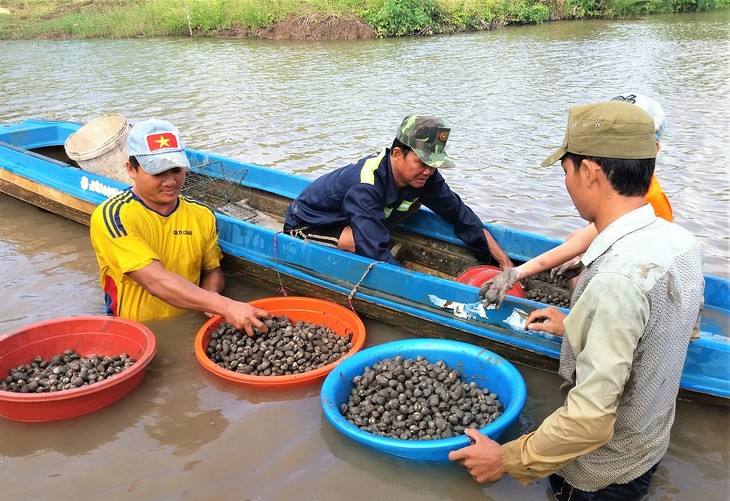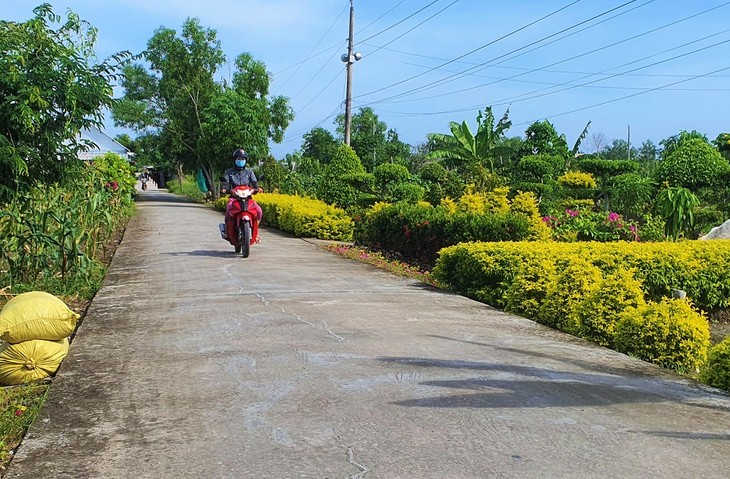(VOVWORLD) - Dong Thoi, a remote commune in Cai Nuoc district, Ca Mau province, has found a way out of poverty. Blood cockle farming has radically changed Dong Thoi and improved people's lives.
 People in Dong Thoi commune have become better-off, thanks to blood cockle farming in shrimp ponds. (VOV photo taken before social distancing is imposed) People in Dong Thoi commune have become better-off, thanks to blood cockle farming in shrimp ponds. (VOV photo taken before social distancing is imposed) |
Raising blood cockles in Dong Thoi’s shrimp ponds began in 2010 when some disadvantaged locals started raking sea blood cockles to earn extra income.
After the trial in which the blood cockles grew fast while being raised with shrimp, the Dong Thoi farmers decided to expand the model, which has already made the farmers in Kinh Lon hamlet rich. Spacious houses have mushroomed.
Mai Van Tho, a villager who has raised blood cockles for just 2 years, already has enough money to build a new house.
He told VOV that in the past, he and his neighbors made their living raising shrimp and crabs in ponds. But his family didn’t have much land and remained poor.
When the model of blood cockle farming began to flourish in the commune, Tho decided to devote his family’s 0.7 ha of land to raising this species of clam. He made nearly 8,900 USD from his 2017 harvest. A couple years later his family replaced their crude wooden shack with a more spacious walled house.
“I also raise shrimp and crabs, in small quantities, but I mainly rely on blood cockles. Blood cockles give high yields and strong profits, improving our living condition. And it’s easier than raising crabs,” according to Tho.
 Upgraded roads in Dong Thoi commune look beautiful (Photo: VOV) Upgraded roads in Dong Thoi commune look beautiful (Photo: VOV) |
The blood cockle farming model came along just as Dong Thoi commune was beginning a new-style rural building program. The blood cockle has been selected as one of the commune’s spearhead economic products.
With a profit of about 4,400 USD per hectare per year, many households in Dong Thoi have escaped poverty and become well-off.
The current per capita income is more than 2,200 USD a year, twice as much as when the new-style rural building began 11 years ago.
As their living conditions have improved, people have become more willing to contribute their money and efforts to renovating their homeland.
For example, a 3.5 km paved road was completed in Kinh hamlet Number 1 last year, thanks to villagers’ land donations.
When the local government announced plans to create a garbage pit and improve public areas, the villagers responded immediately, as they no longer have to struggle to earn their daily “bread and butter”. This was while simultaneously complying with social distancing regulations, said local resident Nguyen Van Dot.
“We have continued working in the fields and beautifying the areas around our houses, because we were told our commune might be recognized as a new-style rural village this November. If we don't do it, how can we be recognized? Commune officials have encouraged us to do the upgrading, but we must strictly follow the Ministry of Health’s epidemic regulations whenever we go outside,” said Dot.
When the new-style rural development program began in 2010, Dong Thoi had met only 3 criteria. Now it only needs 3 more criteria to reach the finish line.
Vo Van Trieu, Chairman of the commune’s People’s Committee, said, “Of course, we face certain difficulties caused by the pandemic. But we’re determined to reach our goals by dividing into small groups and mobilizing every household to complete its tasks. Social distancing is an advantage in some ways. Since everyone has to stay at home, it’s easier to see what has been completed, and focus on unfinished tasks.”
Expanding production and improving people's income and living standard are important criteria for new-style rural areas. Dong Thoi’s success in fulfilling these criteria has helped the once disadvantaged commune mobilize people to contribute to the new-style rural building process.